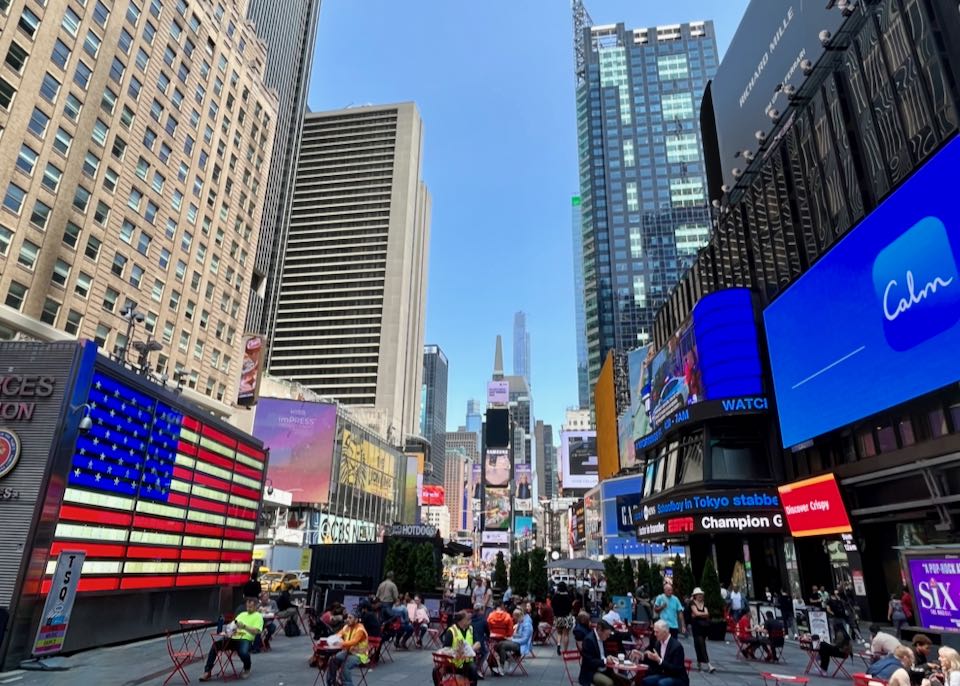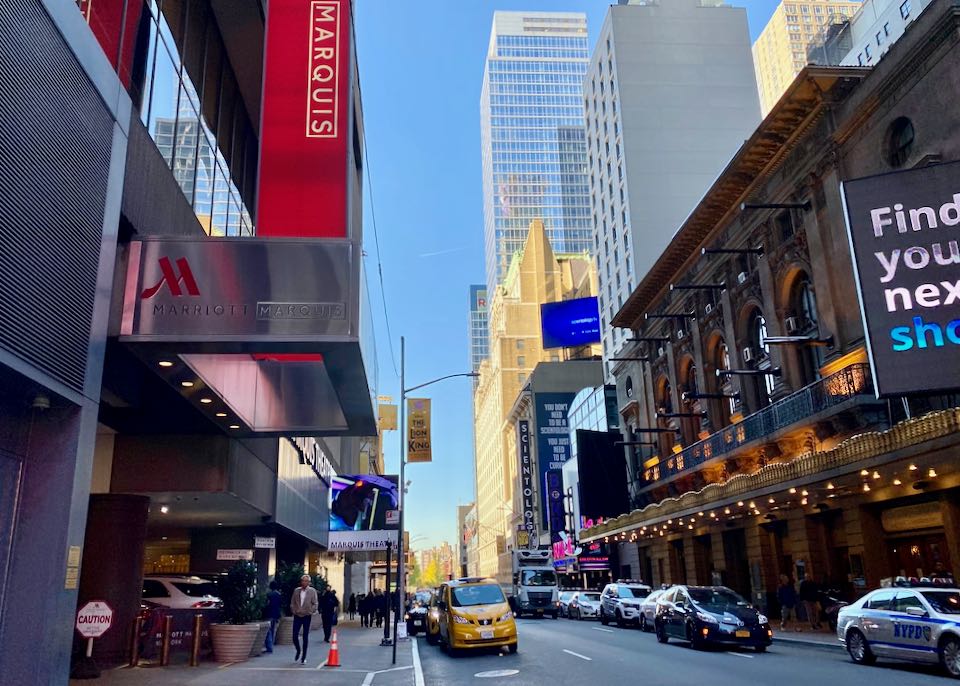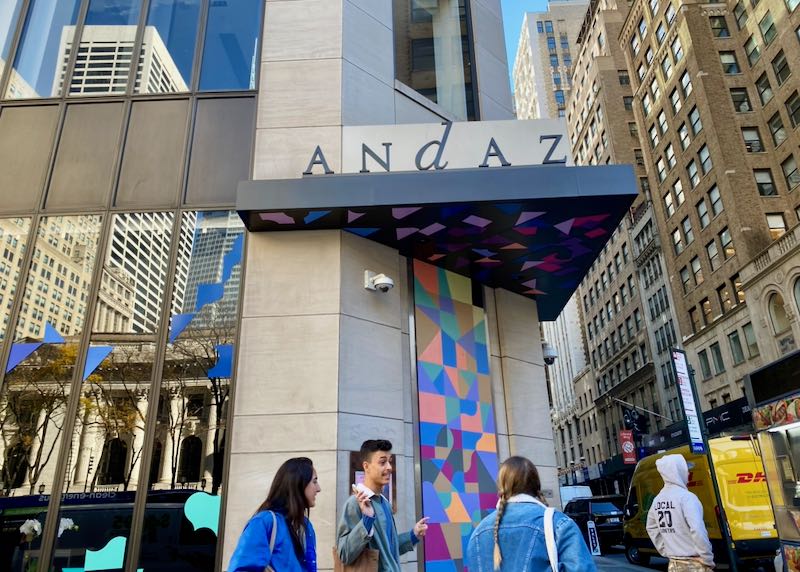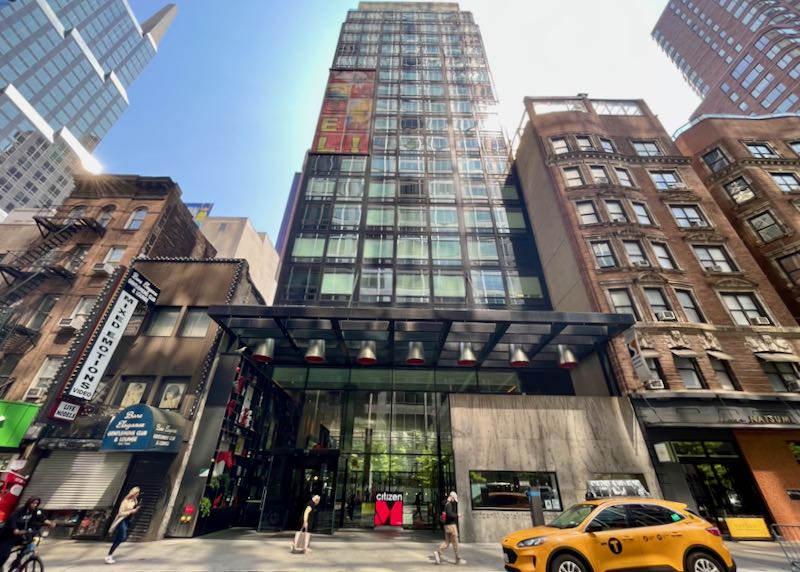My Favorite Hotels in NYC
• 5-star: Mandarin
• 4-star: Archer • Pendry
• 3-star: citizenM • Sheraton
• For families: Lowell • AKA
• For couples: Library • Crosby
• Times Square: Marriott
• Central Park: Pierre
• Penn Station: Renaissance
• Grand Central: Library
• Empire State Bldg: Langham
• Lower Manhattan: Crosby
• Financial District: Beekman

Times Square and the Theater District is the best place to stay for first-time visitors to New York.
16 Tips for NYC First-Timers
1. Reserve Early
New York hotels fill up fast – especially near the Theater District. Lock in your reservation a few months ahead for a better rate and preferred options.2. Stay in the Theater District
This neighborhood is a prime launchpad for first-timers: Broadway shows at your doorstep, close proximity to Times Square, and easy access to multiple subway lines.3. Embrace the Subway
The city that never sleeps also rarely stops moving. Pick up a MetroCard (or use tap-to-pay) for 24/7 rides. Avoid rush hours (8-9 a.m. and 5-7 p.m.) if possible to dodge crowds.4. Catch a Broadway Show
Book your tickets in advance for popular musicals or plays – sold-out nights are common. For last-minute deals, try the TKTS booth in Times Square, but expect queues.5. Walk, Walk, Walk
New York’s grid layout makes it relatively simple to navigate on foot. Strolling is the best way to savor the city’s energy, spot hidden gems, and burn off that bagel or slice of pizza. The recent addition of congestion pricing has happily reduced vehicle traffic in Manhattan and made the borough more walkable than ever.6. Time Square Savvy
Times Square is a must-see once, but it’s often jam-packed. Visit in the evening for the neon spectacle, then retreat to quieter side streets for dinner or drinks.7. Explore Central Park
Just a short stroll from the Theater District, Central Park offers a peaceful escape from Manhattan’s hustle. Rent a bike or take a leisurely walk – particularly scenic in spring and fall.8. Enjoy the View
The Empire State Building and Top of the Rock both provide iconic skyline panoramas. For fewer crowds, visit early or go late for glistening city lights.9. Mind the Traffic
Pedestrian crossings can be intense – jaywalking is part of local culture, but stay alert and only follow the crowd if you’re comfortable.10. Dine Away from Times Square
While theater district spots cater to pre-show diners, the city’s real culinary magic often lies in side-street eateries, Hell’s Kitchen hotspots, or a quick subway ride to neighborhoods like the West Village or the Upper West Side.11. Be Prepared to Tip
In NYC, tipping is customary and typically 18-20% in restaurants. Don’t forget your bartenders, taxi drivers, and hotel bellhops if you appreciate good service.12. Museum Strategy
The Met, MoMA, and the American Museum of Natural History can be overwhelming – pick a few highlights rather than trying to see everything in one go.13. Explore Other Neighborhoods
Greenwich Village, SoHo, and the Lower East Side each have distinct vibes worth sampling. Factor in an afternoon to explore boutiques, cafés, and local haunts off the tourist trail.14. Sample the Classics
No trip is complete without a genuine New York slice or a bagel and schmear. Midtown delis can satisfy cravings, but venturing to local-favorite joints can add authenticity.15. Get a CityPASS or Other Passes
These can save time and money if you plan to hit multiple attractions, from the 9/11 Memorial & Museum to the Statue of Liberty ferry.16. Give Yourself Wiggle Room
Whether it’s a surprise performance in the subway or a last-minute dinner reservation at a Michelin-starred restaurant, NYC’s magic often pops up spontaneously. Keep your schedule flexible enough to seize those unexpected moments.What is best area to stay in NYC for a first-time visitor?
The Theater District, located in the heart of New York City, is an ideal area for first-time visitors due to its central location and proximity to numerous iconic attractions such as Times Square, Rockefeller Center, and Radio City Music Hall. As the epicenter of the world-renowned Broadway theater scene, it offers visitors the unique opportunity to experience a Broadway show just steps away from their accommodation. The district also boasts excellent transportation links with several subway lines converging at Times Square, allowing easy exploration of other parts of the city. In addition to its vibrant nightlife, the area offers a wide range of dining and shopping options to cater to different tastes and budgets.
Why stay in the Theater District?
• Central Location: Situated in the heart of Manhattan, this area is central to numerous NYC landmarks. This makes sightseeing very convenient, reducing the need for extensive travel.
• Broadway Shows: The Theater District is the epicenter of the world-renowned Broadway theater scene. If you’re interested in seeing a Broadway show, there’s no better place to be.
• Iconic Attractions: Times Square itself is a must-see for first-time visitors. Nearby, you’ll also find attractions such as Rockefeller Center, Radio City Music Hall, and the Museum of Modern Art.
• Excellent Transportation: Many subway lines converge at Times Square, making it an excellent base for exploring other parts of the city.
• Variety of Accommodation: The area offers a wide range of hotels, catering to different budgets and preferences.
• Dining and Shopping: The Theater District and Times Square boast a variety of restaurants and shopping outlets, from well-known (and very touristy) chain establishments to unique local offerings.
• Nightlife: Times Square is one of the city’s most vibrant areas at all hours, making it a great area if you enjoy nighttime entertainment.
Location of Theater District
The Theater District is located in Midtown Manhattan, with its boundaries roughly extending from 42nd Street to 50th Street vertically and from Sixth Avenue to Eighth Avenue horizontally. This compact area is home to over 40 professional theaters (including iconic productions like The Lion King, Hamilton, and Wicked), many of which are situated along Broadway, the district’s central artery. The district’s southern border, 42nd Street, features major landmarks such as Times Square and the iconic New York Public Library, while its northern end, around 50th Street, hosts cultural institutions like the Radio City Music Hall and the Museum of Modern Art. Just a short walk away is Fifth Avenue, renowned for its high-end boutiques and flagship stores, including Saks Fifth Avenue, Bergdorf Goodman, and the iconic Apple Store. The area is well-connected to the rest of the city, with multiple subway lines converging at the 42nd Street Broadway subway stop and the nearby Port Authority Bus Terminal.
History of Theater District
The history of the Theater District dates back to the late 19th century when entertainment venues began to emerge around Union Square and Herald Square. As Manhattan expanded northward, theaters started to relocate to the Times Square area, attracted by lower rents and the opening of the city’s first subway lines. By the early 20th century, the Theater District had firmly established itself as the heart of New York’s performing arts scene, with numerous theaters lining Broadway and surrounding streets. The district flourished during the “Golden Age” of Broadway in the 1920s and 1930s, hosting iconic productions and attracting legendary talent. Despite facing challenges during the Great Depression and a period of decline in the mid-20th century, the Theater District experienced a resurgence in the 1980s and 1990s, fueled by revitalization efforts, investment in infrastructure, and renewed interest in live theater. Today, the Theater District is a thriving cultural and entertainment hub, attracting millions of visitors each year to its Broadway shows, restaurants, and shops. The area is home to over 40 Broadway theaters, as well as numerous off-Broadway venues.
Transportation for Theater District
The Theater District in New York City is well-served by public transportation, making it easy to access from various parts of the city. Multiple subway lines pass through the area, with key stations such as Times Square-42nd Street (serving the 1, 2, 3, 7, N, Q, R, W, and S lines) and 50th Street (serving the C and E lines). Additionally, the Port Authority Bus Terminal, located on 42nd Street and 8th Avenue, is the city’s main bus hub for both local and intercity buses. Furthermore, the Theater District is within walking distance of several other subway stations, such as 49th Street (N, Q, R, and W lines) and 42nd Street-Bryant Park (B, D, F, and M lines). Taxis and rideshare services, like Uber and Lyft, are also readily available
Dining in the Theater District
The Theater District offers a diverse range of dining options, catering to different tastes, preferences, and budgets. The area’s strengths lie in its wide variety of cuisines, from casual eateries and fast-food chains to upscale, fine dining establishments. One notable street for dining in the district is Restaurant Row, located on 46th Street between Eighth and Ninth Avenues, featuring a diverse selection of restaurants offering Italian, Thai, Brazilian, and many other international cuisines. Additionally, the Theater District is home to several iconic establishments, such as Sardi’s and Joe Allen, which are frequented by theatergoers and Broadway celebrities alike.
Hotels in the Theater District

The Marriott Marquis has a fantastic location in the heart of the Theater District. Great for first-timers.
The Theater District boasts a diverse hotel scene, encompassing luxury establishments, midrange boutique and branded properties, and budget-friendly accommodations.
The luxurious Chatwal has an Art Deco-inspired design, a serene spa, and fine dining at The Lambs Club. CitizenM provides a stylish and comfortable midrange option with compact, well-designed rooms and a lively bar. The iconic Knickerbocker Hotel exudes elegance and features a stunning rooftop bar with panoramic city views. The eco-conscious 1 Hotel Central Park combines sustainability with modern design, focusing on natural materials and green initiatives. The sophisticated WestHouse Hotel New York offers personalized services and a residential feel, while the budget-friendly Moxy NYC Times Square presents trendy, compact rooms and a vibrant social scene. The boutique Casablanca Hotel creates a charming, Moroccan-inspired oasis with attentive service and a serene ambiance. The elegant InterContinental New York Times Square provides luxury and comfort with spacious rooms and a renowned French brasserie. The stylish W New York – Times Square showcases a contemporary design, a pulsating nightlife scene, and innovative dining options. Lastly, the refined and classic JW Marriott Essex House New York, situated at the edge of the Theater District, offers luxury accommodations, a prestigious location, and views of Central Park.
What are the best luxury hotels in the Theater District?
The Andaz 5th Avenue near Times Square.
• The Chatwal: This luxury Art Deco-inspired hotel offers a sophisticated atmosphere, a renowned spa, and fine dining at The Lambs Club, providing guests with an exceptional experience in the heart of the city.
• Andaz 5th Avenue: This stylish boutique hotel, situated just steps from the New York Public Library and Bryant Park, provides a chic and contemporary retreat in the heart of Manhattan. The Andaz 5th Avenue offers spacious and well-designed rooms, a sophisticated bar and lounge, and a range of personalized services
• The Knickerbocker Hotel: A historic and iconic hotel, The Knickerbocker features elegant accommodations, a stunning rooftop bar with panoramic city views, and upscale dining options, creating an unforgettable stay.
• The WestHouse Hotel New York: Combining personalized services with a residential feel, this boutique hotel offers a luxurious experience in a sophisticated setting, featuring an exclusive resident’s lounge and stylish guest rooms.
• InterContinental New York Times Square: This elegant hotel provides luxury accommodations, spacious rooms, and a renowned French brasserie. Its prime location and attentive service make it an ideal choice for discerning travelers.
• W New York – Times Square: With contemporary design, luxurious amenities, and innovative dining options, this stylish hotel is known for its vibrant atmosphere and pulsating nightlife scene, offering a unique and upscale experience in the Theater District.
• Marriott Marquis: Located in the heart of Times Square, this iconic hotel offers comfortable guest rooms, a variety of on-site dining options, and stunning city views from its revolving restaurant and lounge.
What are the best midrange hotels in the Theater District?
The citizenM Times Square is an excellent mid-range hotel in the Theater District.
• citizenM Times Square: A modern and stylish hotel, citizenM offers compact yet comfortable rooms with high-tech amenities, a chic rooftop bar, and a 24-hour canteen-style eatery, making it a popular choice for travelers seeking a contemporary experience.
• AKA Times Square: This extended-stay hotel features sophisticated, apartment-style accommodations with fully equipped kitchens and living spaces. AKA Times Square offers the comforts of home, combined with hotel amenities and services, making it ideal for longer stays.
• Riu Plaza Times Square: This contemporary hotel offers stylish guest rooms, on-site dining options, and a range of modern amenities, all within a convenient location in the heart of the Theater District.
• Hampton Inn Manhattan/Times Square Central: A reliable and comfortable option, this Hampton Inn provides spacious guest rooms, complimentary breakfast, and a convenient location within walking distance of major attractions, making it a great choice for travelers seeking value and comfort.
• Hotel Edison: A historic hotel with Art Deco charm, Hotel Edison offers a blend of modern amenities and classic design elements. Its prime location and on-site dining options, including the iconic Rum House, make it a popular choice for guests seeking a balance of style and affordability.
• The Pearl Hotel: This boutique hotel features well-appointed guest rooms, personalized service, and complimentary continental breakfast. Its convenient location and cozy atmosphere make The Pearl Hotel an attractive option for travelers seeking a more intimate experience in the heart of the Theater District.
What are the best cheap hotels in Manhattan?
• Pod Times Square: This modern hotel features compact, pod-style rooms with basic amenities and a sleek design, making it an excellent choice for budget-savvy travelers seeking a clean and efficient place to stay close to the Theater District.
• HI NYC Hostel: Although not located directly in the Theater District, this highly-rated hostel on the Upper West Side offers affordable dormitory-style accommodations and private rooms, with easy access to the Theater District via subway. Amenities include a guest kitchen, common areas, and organized activities, making it a popular choice for budget travelers and backpackers.
What are other good neighborhoods in NYC for first-timers?
SoHo: Located in Lower Manhattan, SoHo (short for “South of Houston Street”) is known for its historic cast-iron architecture, cobblestone streets, and trendy atmosphere. The neighborhood is a hub for fashion, art, and design, featuring high-end boutiques, art galleries, and stylish restaurants. SoHo is also home to numerous designer flagship stores and unique independent shops.
Greenwich Village: Nestled in Lower Manhattan, Greenwich Village offers a charming, bohemian atmosphere with a rich cultural history. The neighborhood is characterized by its tree-lined streets, historic brownstones, and intimate cafes. Washington Square Park serves as the neighborhood’s centerpiece, often bustling with street performers, musicians, and chess players. Greenwich Village is also home to the iconic New York University and has a vibrant nightlife scene.
Upper West Side: Situated between Central Park and the Hudson River, the Upper West Side is a primarily residential neighborhood with a relaxed, family-friendly atmosphere. The area is home to numerous cultural institutions, including the American Museum of Natural History, the Lincoln Center for the Performing Arts, and the Beacon Theatre. Riverside Park and Central Park provide ample opportunities for outdoor activities, and the neighborhood features a variety of shops, restaurants, and cafes along Broadway and Amsterdam Avenue.
Lower East Side: Known for its immigrant history and vibrant nightlife, the Lower East Side is a dynamic and diverse neighborhood. The Tenement Museum offers a glimpse into the area’s past, while contemporary art galleries and innovative restaurants showcase its ongoing evolution. The neighborhood is also home to the historic Katz’s Delicatessen and the bustling Essex Market, a food hall featuring various vendors and eateries.
Williamsburg, Brooklyn: Across the East River from Manhattan, Williamsburg is a trendy, creative neighborhood with a distinct Brooklyn vibe. The area boasts a thriving arts and music scene, as well as an array of vintage shops, artisanal food markets, and craft breweries. The waterfront offers stunning views of the Manhattan skyline, and Smorgasburg, a popular weekend food market, attracts food enthusiasts from all over the city.
Dumbo, Brooklyn: Dumbo (short for “Down Under the Manhattan Bridge Overpass”) is a picturesque neighborhood located along the East River waterfront. Known for its stunning views of the Manhattan skyline and the Brooklyn and Manhattan Bridges, the area is home to converted warehouses, upscale boutiques, art galleries, and trendy eateries. The nearby Brooklyn Bridge Park offers plenty of green space and recreational activities.
What is the best way to get around Manhattan for tourists?
The best way to get around Manhattan will depend on your personal preferences and where you’re staying. Popular options for tourists include:• Subway: The extensive subway system in New York City is a fast and cost-effective way to navigate Manhattan. With multiple lines running through the borough, the subway can get you to most destinations quickly.
• Buses: The bus can be better than the subway when traveling shorter distances or across town, where subway lines may not provide direct routes. Buses offer better accessibility for individuals with mobility impairments, as many subway stations lack elevators.
• Walking: Manhattan is a walkable city, and exploring on foot can be an enjoyable and healthy way to experience the urban environment. Walking is particularly suitable for shorter distances or when you want to take in the sights and sounds of the city.
• Biking: The city has made significant investments in bike infrastructure, including protected bike lanes and bike-sharing programs like Citi Bike. Biking can be a quick and eco-friendly way to travel through Manhattan, but be sure to follow traffic rules.
• Taxis and rideshares: Yellow taxis and rideshare services like Uber and Lyft are widely available in Manhattan. They offer a convenient, albeit sometimes pricier, option for getting around, especially when you’re in a hurry or traveling with luggage.
• Car services: For a more luxurious experience, you can hire a private car service or limousine, which can be booked in advance or on-demand through various apps or by calling a local car service company.
• Ferries: While not as comprehensive as other transportation options, NYC Ferry services can be a scenic and enjoyable way to reach destinations along the East River or Hudson River, such as the Financial District, Midtown, or Upper West Side.
• Driving: Unless planning a day trip outside the city, driving is not recommended.
Is the subway easy to use in New York City?
Yes, the subway is generally easy to use in New York City once you get the hang of it. It’s an affordable and convenient way to get around the city, and it’s a great option for tourists – though for first-timers it can be understandably intimidating.How do you use the subway in New York City?
To use the subway in New York City, follow these steps:• Plan your route: Use a subway map or a smartphone app like Google Maps or the MTA’s MYmta app to plan your route. Determine which train lines you need to take and the direction you need to travel (Uptown, Downtown, Brooklyn, Queens, or the Bronx).
• Find a subway station: Locate the nearest subway station entrance, which is usually marked by a green or red globe at the top of the stairs or a freestanding sign indicating the subway lines served by the station.
• Purchase a MetroCard: Before entering the subway, you’ll need to buy a MetroCard from a MetroCard vending machine or a station booth, if available. You can choose from various fare options, such as pay-per-ride, weekly, or monthly passes. Follow the instructions on the vending machine to complete your purchase.
• Swipe your MetroCard: At the turnstile, swipe your MetroCard through the card reader, making sure the magnetic strip is facing you and pointing downward. If your swipe is successful, the display will show “GO” and you can proceed through the turnstile. If not, try swiping again, ensuring you maintain a steady speed.
• Locate the correct platform: Once inside the station, follow the posted signs to the platform for your desired train line and direction, then board the train.
• Transfer, if necessary: If your route requires transferring to another line, exit the train at the designated transfer station and follow signs to the connecting train’s platform. You usually don’t need to swipe your MetroCard again for transfers within the subway system, but always check the signs.


About Santorini Dave